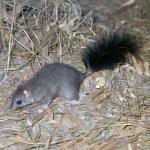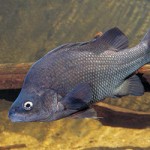Australia has one of the highest rates of mammal extinction in the world, and since Black Saturday, more animals are under threat.
The area where Black Saturday happened provided natural habitat for many species, and sadly, many are more threatened and endangered due to destruction of their habitat.
This series of Endangered Species articles will examine some of the species under threat in this area and increase awareness of their plight.
 Brush-tailed PhascogaleThe Brush-tailed Phascogale is a carnivorous, nocturnal marsupial. It is also arboreal in nature, carrying out the majority of activities in trees tops and on trunks. The top of the head, back, legs and arms are covered in deep grey fur, with a pale creamy underbelly. The ears are bald and the distinctive bottle-brush tail is a deep black colour and around the same length as their body – about 20 centimetres for males and 17 centimetres for females. The Brush-tailed Phascogale is a rare, endangered species.
Brush-tailed PhascogaleThe Brush-tailed Phascogale is a carnivorous, nocturnal marsupial. It is also arboreal in nature, carrying out the majority of activities in trees tops and on trunks. The top of the head, back, legs and arms are covered in deep grey fur, with a pale creamy underbelly. The ears are bald and the distinctive bottle-brush tail is a deep black colour and around the same length as their body – about 20 centimetres for males and 17 centimetres for females. The Brush-tailed Phascogale is a rare, endangered species.
 Macquarie Perch
Macquarie Perch
The endangered Macquarie Perch can be black, silver-grey, blue-grey or green-brown in colour, with a paler underside and are found in both river and lake habitats; especially the upper reaches of rivers and their tributaries. They are quiet, furtive fish that feed on aquatic insects, crustaceans and molluscs. They were in King Parrot Creek (Kinglake to Flowerdale) and programs are in place for their recovery in this area. The creek didn’t burn as much as others, but siltation has been a problem.
 Spot-tailed Quoll
Spot-tailed QuollSpot-tailed Quolls are recognised by conspicuous white spots over the body and tail; no other quoll species in Australia has a spotted tail. Their fur colour ranges from light to very dark brown, and they can also be identified by their relatively large head with a wide jaw gape and long, curved canine teeth. A threatened species, the Spot-tailed Quoll is the largest marsupial carnivore on mainland Australia. In the breeding season, male Spot-tailed Quolls typically emit a slow, deep growl and a loud, explosive spitting sound. They are generally solitary animals that occur at low densities as they occupy huge home ranges, from 2,000 to 4,500 hectares for males and 600 to 1,200 hectares for females.
This is the first article in a four-part series on Black Saturday endangered species.


THANK YOU SO SO SO MUCH YAY IM SO EXCITED YOU HELPED ME OUT!!!
Hi
I have a brush tailed phasogale on my property. I saw it a couple of weeks ago and I have been trying to find out what it was since then. Thanks for your photo before I saw it I thought the animal was some sort of quoll.
I heard a weird screaming sort of noise coming from outside and went out to see a green tree frog fighting for its life with this brushy tailed possum looking thing. It was the frog that was screaming.
I must have startled it with my torch because it went away.
When I described it to my husband he said that this was the same creature that had tried to make off with one of our chooks under its arm one night.
Do you have any more info on it?
Hi Toni
Thanks so much for your feedback. We loved reading your story, particularly the ‘tried to make off with one of chooks under its arm one night’. Gold.
For more information, I would ask Sharon or Nigel at http://www.australiananimalrescue.org.au
They are always a wealth of information on Australian natives.
If you find out more, let us know … we love it when we can post stories and articles from our readers!